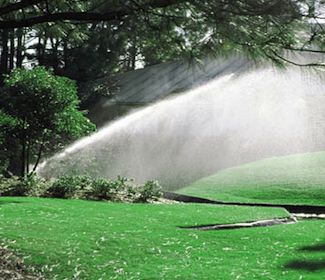Water Saving Tips For Your Landscape

Water Saving Tips - Rainbird Irrigation
During the long hot days of summer, your lawn can really suffer without a little help from you. Traditional grass lawns require a lot of water to stay green and healthy, usually around an inch of water a week. When nature doesn't provide enough rain, most lawns need at least a little supplemental irrigation; in very dry periods, irrigation may have to supply all of the lawn's water.
That raises concerns over how we utilize our water resources. In many parts of the country, water from ground and surface sources is being used faster than it can be replenished. Over half of urban water use in the U.S. is for landscape irrigation, and for individual homes, often times far more water is used outside the home than in.
We should all be concerned about how our precious water resources are used. There are many ways to keep your home's outdoor areas healthy and beautiful without using tremendous amounts of water. As with any natural resource, the less water used typically means less money spent; and that's always a good thing.
Water Saving Tip #1: Give Up The Grass
Grass lawns need lots and lots of water. Even in areas that receive ample amounts of rain, some additional irrigation is usually required to keep the lawn lush and green. Obviously, the best way to reduce water usage for your lawn is to not have the lawn in the first place. For more information on minimizing or elimination your grassy areas, visit our article on Grass Alternatives.
Consider replacing grassy areas with landscaping featuring drought-hardy native plants. Plants native to your region are almost always going to need less water than non-native plants; drought-resistant plants can reduce or even eliminate the need for watering, while still giving you an attractive outdoor area. Designing a landscape with water conservation in mind is also known as Xeriscape landscaping.
Water Saving Tip #2: Choose Your Lawn Wisely
Some people simply don't want a yard without grass; some areas may even mandate it. Your landscaping choices are as personal as your home, and many enjoy the look of a lush, green lawn. Our job is to help you achieve your dream lawn using as little water as possible.
Water Saving Tip #3: Keep it Small
In addition to requiring lots of watering, large lawns also take hours and hours of maintenance each week. Instead of wasting all that time and water, consider shrinking your lawn down to a more manageable level. By placing more emphasis on your planting beds and accenting them with lawn areas, you will find that it will provide your landscaping with a much more professional look and one that will invite visitors to stroll through your landscape, rather than looking at a sea of grass.
Water Saving Tip #4: Mulch It Up
If your home is on a large lot, you can augment the lawn areas with landscaped areas that aren't going to need all that water (or mowing!) Use layers of mulch around trees and plants in landscaped areas will retain moisture, reducing the need to water even further. There are several mulch options that are available to the homeowner that are both eco-friendly and will promote water conservation. Visit our article on Mulch Types for some great information on what each mulch can do for your garden and how it is best utilized in your yard.
Water Saving Tip #5: Plant Drought Resistant Plants
The EPA's WaterSense program recommends limiting grass turf areas to a maximum of 40% of the site for a single-family home, with the rest of the yard containing drought-resistant plantings and permeable hard surfaces. There are commercially-available grasses that are naturally drought-resistant, and can be a great choice for a yard in areas with lots of sunshine and little natural water.
Many of the most popular grasses, like Kentucky Bluegrass, don't handle drought well, consuming large amounts of water. See our article on drought-resistant grasses for more information.
Water Saving Tip #6: Raise Those Blades
Simply raising the level of your lawn mower blades can help; longer grass in your lawn can help reduce water consumption by shading the soil, allowing it to retain moisture longer. You will find that with taller grass blades, your lawn looks healthier, grows better, is more disease tolerant, and since the weed seeds need light to germinate, you will experience less of a weed problem.
comments powered by Disqus


































































